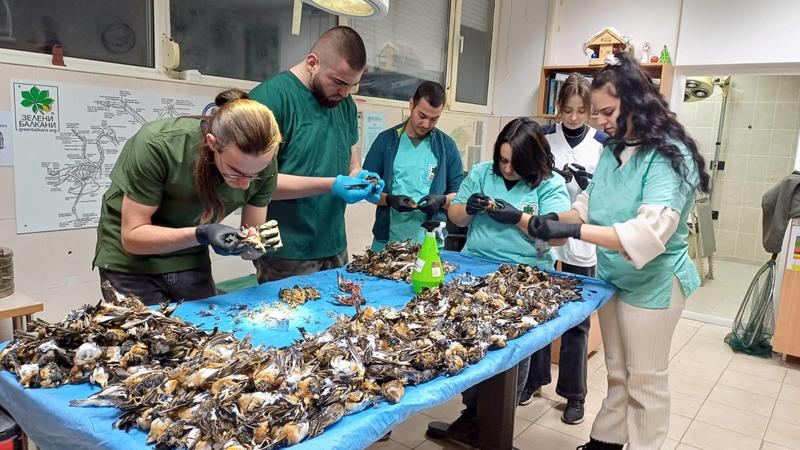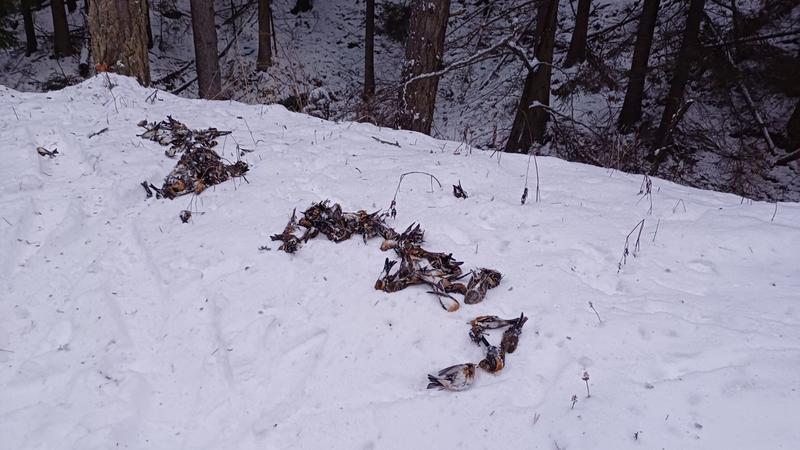Species monitoring data shows a very high number of dead mountain finches for the country
03 Jan, 2025 | 17:00
- RIEW - Sofia, on whose territory the incident occurred, has alerted the "Crimes against the Environment and Wildlife" sector at the General Directorate of the National Police
- In 2025, Bulgaria is to present data on the number of the species in the country for the last 6 years
In addition to the over 1000 mountain finches that had died according to a signal from January 1, 2025 at the "Green Balkans" Wildlife Rescue Center, there is also data on other, smaller numbers of dead songbirds at other locations. These signals have not been received by "Green Balkans", therefore reliable information cannot be provided at the moment.
RIEW - Sofia, on whose territory the incident occurred, has alerted the "Crimes against the Environment and Wildlife" sector at the General Directorate of the National Police with a proposal to conduct an inspection in view of data for a crime of a general nature.
The mountain finch (Fringilla montifringilla) is a protected species included in Annex No. 3 to the Biological Diversity Act. For the animal species in Annex No. 3, the following are prohibited: all forms of intentional capture or killing of specimens with any devices, means and methods; persecution and disturbance, especially during the periods of reproduction, rearing of the young, wintering, and migration; destruction or removal of eggs, including in cases where they are abandoned; destruction, damage or relocation of nests; damage or destruction of breeding, resting and gathering places during migration; removal of found dead specimens; possession, breeding, transfer, transport, export abroad, trade and offer for sale or exchange of specimens taken from the wild; taxidermy, possession, display in public places, transfer, transport, export abroad, trade and offer for sale or exchange of taxidermy specimens. The prohibitions apply to all life stages of animal development.
All species of birds found in the wild on the territory of the country, including all species of songbirds, are strictly protected by the provisions of the Biodiversity Act.
According to the official information provided by the Executive Environment Agency (EEA), the monitoring records for the species of the mountain finch include 1534 specimens for 2024. The data on the species, maintained in the National System for Monitoring the Status of Biodiversity (NSMSB), were provided to the EEA by the Bulgarian Society for the Protection of Birds (BSPB). They are collected mainly under the monitoring scheme "Midwinter Census of Waterbirds in Bulgaria", which is part of the general international census, but since the mountain finch species is not a key one and is not reported by Bulgaria to Wetlands International, it should be borne in mind that the indicated numerical data are neither exhaustive, nor unrepresentative.
According to the Birds Directive, Bulgaria is due to submit data on the number of the species in the country for the last 6 years in 2025. At the moment, the reporting data is being prepared by the Bulgarian Bird Protection Service, and the summarized information cannot be given with accuracy before June 2025. In any case, the number of mountain finch deaths is very high.
The mountain finch (Fringilla montifringilla) does not breed in Bulgaria, but only winters, often forming mixed flocks with the common finch (Fringilla coelebs) and other passerine birds. The species nests in Northern and Central Europe in coniferous forests. In Bulgaria, during wintering, flocks may become larger and gather near cities where there is suitable food for the season (for example, ash seeds), respectively, large roosts may form near some settlements, as is the case with Koprivshtitsa.
Songbirds, including the mountain finch, are diurnal, and therefore, when exposed to significant sound and light at night, they may become disoriented, leave their roosts, encounter obstacles, be startled in the air by fireworks or other loud and sudden noises, suffer from stress, and be forced to fly irregularly in the air at night (the so-called "panic flight" rather than normal flight), causing their heart rate to increase sharply, severe metabolic and hormonal disturbances, and in some cases internal damage (hemorrhages). High levels of noise and light, the combination of effects, including direct bodily damage, can lead to immediate death. Without such anxiety, the birds would probably have remained in their roosts.
Fireworks, light and noise pollution represent a very specific form of disturbance and cause of mortality, which can have significant consequences for the Bulgarian avifauna, including protected and conservationally important species. In addition to the direct consequences, expressed in mortality, immediately after the fireworks, a number of scientific studies also show long-term consequences, such as behavioral and physiological effects (e.g. endocrinological changes), energy losses, leading to a deterioration in the condition of individual specimens and the population as a whole.
According to a number of scientific studies and publications, the effects of fireworks on birds are significant, with a number of similar cases of mass mortality documented immediately after the end of New Year's Eve, including birds falling from the sky. The observations are valid for various bird taxa, including songbirds. Pathoanatomical studies conducted at the Wildlife Rescue Center Green Balkans reported massive hemorrhages in the abdominal cavity and on the skulls of the birds, heart collapse, tissue ruptures and fractures, and no bullets or influenza (flu) were detected in the birds when field tests were applied.
We appeal to raise awareness and manage the process in a more appropriate way, taking into account that a large part of such massive incidents may remain undocumented. It is necessary to limit the extremely strong explosives. Fireworks should not be used in ornithologically important places, national parks and other categories of protected areas, as well as in areas of bird colonies and bird roosts.

